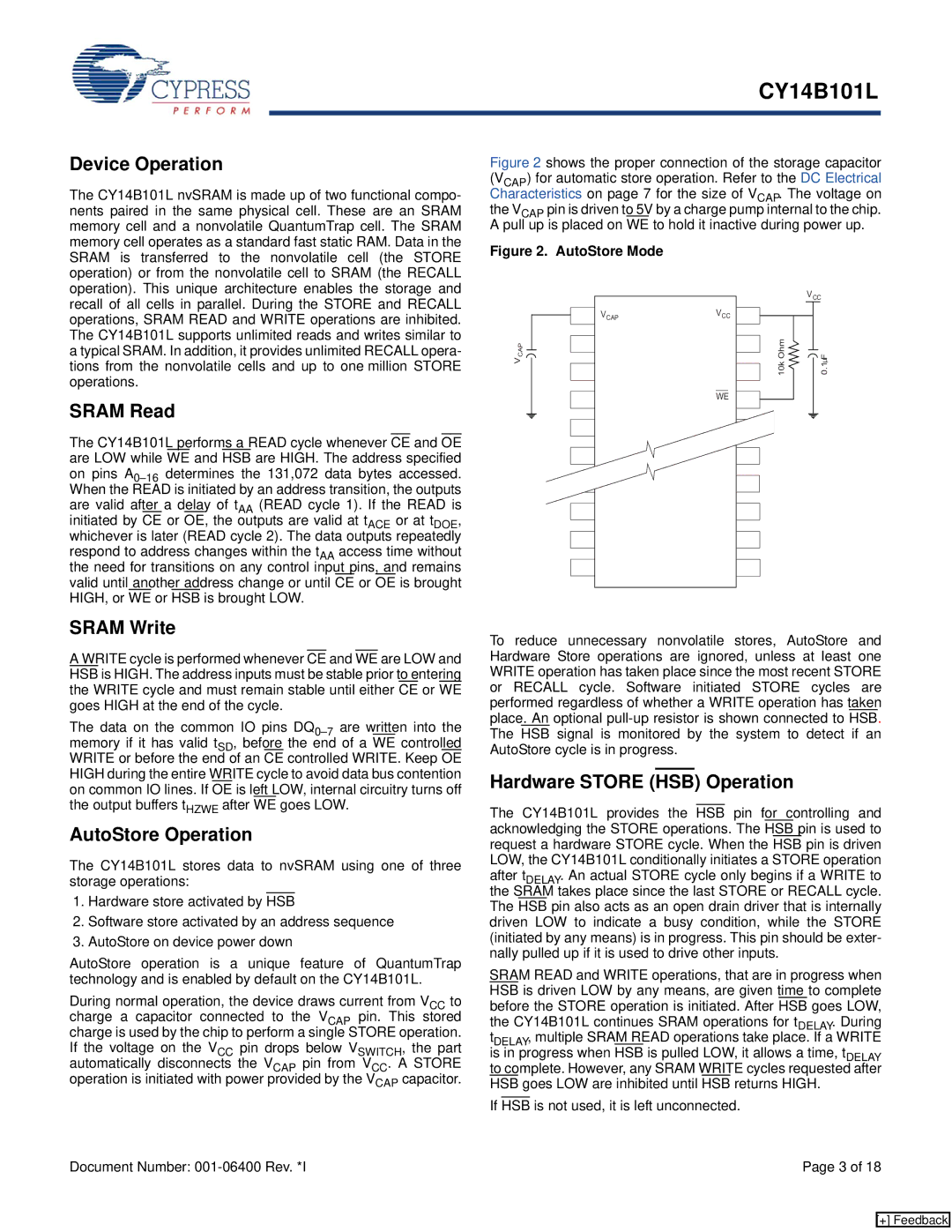
Device Operation
The CY14B101L nvSRAM is made up of two functional compo- nents paired in the same physical cell. These are an SRAM memory cell and a nonvolatile QuantumTrap cell. The SRAM memory cell operates as a standard fast static RAM. Data in the
CY14B101L
Figure 2 shows the proper connection of the storage capacitor (VCAP) for automatic store operation. Refer to the DC Electrical Characteristics on page 7 for the size of VCAP. The voltage on the VCAP pin is driven to 5V by a charge pump internal to the chip. A pull up is placed on WE to hold it inactive during power up.
SRAM is transferred to the nonvolatile cell (the STORE operation) or from the nonvolatile cell to SRAM (the RECALL operation). This unique architecture enables the storage and recall of all cells in parallel. During the STORE and RECALL operations, SRAM READ and WRITE operations are inhibited. The CY14B101L supports unlimited reads and writes similar to a typical SRAM. In addition, it provides unlimited RECALL opera- tions from the nonvolatile cells and up to one million STORE operations.
SRAM Read
The CY14B101L performs a READ cycle whenever CE and OE are LOW while WE and HSB are HIGH. The address specified on pins
Figure 2. AutoStore Mode
VCAPVCC
CAP
V
WE
| VCC |
10k Ohm | 0.1UF |
SRAM Write
A WRITE cycle is performed whenever CE and WE are LOW and HSB is HIGH. The address inputs must be stable prior to entering the WRITE cycle and must remain stable until either CE or WE goes HIGH at the end of the cycle.
The data on the common IO pins
AutoStore Operation
The CY14B101L stores data to nvSRAM using one of three storage operations:
1.Hardware store activated by HSB
2.Software store activated by an address sequence
3.AutoStore on device power down
AutoStore operation is a unique feature of QuantumTrap technology and is enabled by default on the CY14B101L.
During normal operation, the device draws current from VCC to charge a capacitor connected to the VCAP pin. This stored charge is used by the chip to perform a single STORE operation. If the voltage on the VCC pin drops below VSWITCH, the part automatically disconnects the VCAP pin from VCC. A STORE operation is initiated with power provided by the VCAP capacitor.
Document Number:
To reduce unnecessary nonvolatile stores, AutoStore and Hardware Store operations are ignored, unless at least one WRITE operation has taken place since the most recent STORE or RECALL cycle. Software initiated STORE cycles are performed regardless of whether a WRITE operation has taken place. An optional
Hardware STORE (HSB) Operation
The CY14B101L provides the HSB pin for controlling and acknowledging the STORE operations. The HSB pin is used to request a hardware STORE cycle. When the HSB pin is driven LOW, the CY14B101L conditionally initiates a STORE operation after tDELAY. An actual STORE cycle only begins if a WRITE to the SRAM takes place since the last STORE or RECALL cycle. The HSB pin also acts as an open drain driver that is internally driven LOW to indicate a busy condition, while the STORE (initiated by any means) is in progress. This pin should be exter- nally pulled up if it is used to drive other inputs.
SRAM READ and WRITE operations, that are in progress when HSB is driven LOW by any means, are given time to complete before the STORE operation is initiated. After HSB goes LOW, the CY14B101L continues SRAM operations for tDELAY. During tDELAY, multiple SRAM READ operations take place. If a WRITE is in progress when HSB is pulled LOW, it allows a time, tDELAY to complete. However, any SRAM WRITE cycles requested after HSB goes LOW are inhibited until HSB returns HIGH.
If HSB is not used, it is left unconnected.
Page 3 of 18
[+] Feedback
